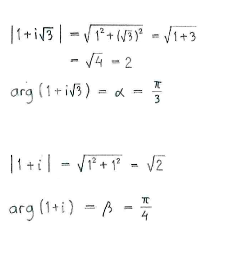Lösung 3.2:6e
Aus Online Mathematik Brückenkurs 2
(Unterschied zwischen Versionen)
K (Solution 3.2:6e moved to Lösung 3.2:6e: Robot: moved page) |
|||
| (Der Versionsvergleich bezieht 2 dazwischen liegende Versionen mit ein.) | |||
| Zeile 1: | Zeile 1: | ||
| - | + | Wenn wir den Zähler und den Nenner auf Polarform bringen, können wir die Division einfach ausführen, indem wir die Betrage dividieren und die Argumente subtrahieren. | |
{{Abgesetzte Formel||<math>\frac{r_1(\cos\alpha+i\sin\alpha)}{r_2(\cos\beta+i\sin\beta)} = \frac{r_1}{r_2}\bigl(\cos (\alpha-\beta) + i\sin (\alpha-\beta)\bigr)\,\textrm{.}</math>}} | {{Abgesetzte Formel||<math>\frac{r_1(\cos\alpha+i\sin\alpha)}{r_2(\cos\beta+i\sin\beta)} = \frac{r_1}{r_2}\bigl(\cos (\alpha-\beta) + i\sin (\alpha-\beta)\bigr)\,\textrm{.}</math>}} | ||
| - | + | Daher schreiben wir den Zähler und den Nenner in Polarform: | |
[[Image:3_2_6_e_bild.gif]] [[Image:3_2_6_e_bildtext.gif]] | [[Image:3_2_6_e_bild.gif]] [[Image:3_2_6_e_bildtext.gif]] | ||
| - | + | und erhalten | |
{{Abgesetzte Formel||<math>\begin{align} | {{Abgesetzte Formel||<math>\begin{align} | ||
Aktuelle Version
Wenn wir den Zähler und den Nenner auf Polarform bringen, können wir die Division einfach ausführen, indem wir die Betrage dividieren und die Argumente subtrahieren.
| \displaystyle \frac{r_1(\cos\alpha+i\sin\alpha)}{r_2(\cos\beta+i\sin\beta)} = \frac{r_1}{r_2}\bigl(\cos (\alpha-\beta) + i\sin (\alpha-\beta)\bigr)\,\textrm{.} |
Daher schreiben wir den Zähler und den Nenner in Polarform:
und erhalten
| \displaystyle \begin{align}
\frac{1+i\sqrt{3}}{1+i} &= \frac{2\Bigl(\cos\dfrac{\pi}{3}+i\sin\dfrac{\pi}{3}\Bigr)}{\sqrt{2}\Bigl(\cos \dfrac{\pi}{4} + i\sin\dfrac{\pi}{4}\Bigr)}\\[5pt] &= \frac{2}{\sqrt{2}}\Bigl( \cos\Bigl(\frac{\pi}{3}-\frac{\pi}{4}\Bigr) + i\sin\Bigl( \frac{\pi}{3}-\frac{\pi}{4}\Bigr)\Bigr)\\[5pt] &= \sqrt{2}\Bigl(\cos\frac{\pi}{12}+i\sin\frac{\pi}{12}\Bigr)\,\textrm{.} \end{align} |


